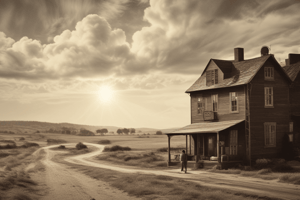Podcast
Questions and Answers
What was a major factor contributing to the Wall Street Crash of 1929?
What was a major factor contributing to the Wall Street Crash of 1929?
- Speculative investment in the stock market (correct)
- Increased production and sales
- Decrease in consumer spending
- Government regulation of the stock market
What was the impact of the Wall Street Crash on brokerages?
What was the impact of the Wall Street Crash on brokerages?
- They expanded their lending operations
- They experienced a surge in profits
- They invested heavily in the stock market
- They called in immense loans and faced difficulties in recovering them (correct)
How did the stock market respond to the warning signs of economic weakening in 1929?
How did the stock market respond to the warning signs of economic weakening in 1929?
- It continued to grow despite the warning signs (correct)
- It crashed immediately
- It experienced a gradual decline
- It remained stable
What characterized much of the investment in the stock market leading up to the crash?
What characterized much of the investment in the stock market leading up to the crash?
What was the response of investors to economist Roger Babson's warnings in September?
What was the response of investors to economist Roger Babson's warnings in September?
How did the Wall Street Crash impact the money supply and demand?
How did the Wall Street Crash impact the money supply and demand?
What was a consequence of the stock market collapse on bank runs?
What was a consequence of the stock market collapse on bank runs?
Which act contributed to a peak unemployment rate of 23% in subsequent years?
Which act contributed to a peak unemployment rate of 23% in subsequent years?
What was the primary focus of the New Deal?
What was the primary focus of the New Deal?
Which program aimed to employ millions in building public utilities and infrastructure?
Which program aimed to employ millions in building public utilities and infrastructure?
What was a notable New Deal initiative for relief?
What was a notable New Deal initiative for relief?
Which was a key New Deal initiative for recovery efforts?
Which was a key New Deal initiative for recovery efforts?
What was the aim of the New Deal's focus on reforming the financial system?
What was the aim of the New Deal's focus on reforming the financial system?
What is debated among historians and economists regarding the New Deal's impact on the Great Depression?
What is debated among historians and economists regarding the New Deal's impact on the Great Depression?
What effect did the New Deal have on the US's GDP and manufacturing over the course of the 1930s?
What effect did the New Deal have on the US's GDP and manufacturing over the course of the 1930s?
Flashcards
Speculative Investment
Speculative Investment
Risky buying and selling of stocks, hoping for quick profits, fueled the crash.
Impact on Brokerages
Impact on Brokerages
Brokerages struggled to recover loaned money, worsening the economic crisis.
Ignoring Warning Signs
Ignoring Warning Signs
Despite warning signs, the stock market kept growing, ignoring fundamental weaknesses.
Investors' Reaction to Warnings
Investors' Reaction to Warnings
Signup and view all the flashcards
Impact on Money Supply
Impact on Money Supply
Signup and view all the flashcards
Bank Runs
Bank Runs
Signup and view all the flashcards
The Tariff Act of 1930
The Tariff Act of 1930
Signup and view all the flashcards
Primary Focus of the New Deal
Primary Focus of the New Deal
Signup and view all the flashcards
Works Progress Administration
Works Progress Administration
Signup and view all the flashcards
New Deal Initiative for Relief
New Deal Initiative for Relief
Signup and view all the flashcards
Fair Labor Standards Act
Fair Labor Standards Act
Signup and view all the flashcards
Aim of Financial Reform
Aim of Financial Reform
Signup and view all the flashcards
New Deal's Impact
New Deal's Impact
Signup and view all the flashcards
Effect on US GDP
Effect on US GDP
Signup and view all the flashcards
Study Notes
The New Deal and Its Impact on the Great Depression
- The Tariff Act of 1930 led to a decrease in international trade and a peak unemployment rate of 23% in subsequent years.
- The Great Depression was a period of high unemployment and economic crisis in the 1930s.
- President Herbert Hoover's reluctance to provide direct relief during the crisis led to public discontent.
- Franklin D. Roosevelt's New Deal was a response to the economic crisis and included new government policies and reforms.
- The New Deal aimed to provide relief, recovery, and reform through various government programs and initiatives.
- Relief programs under the New Deal included the creation of projects and aid for those who had lost their savings and jobs.
- The Works Progress Administration and the Public Works Administration were created to employ millions in building public utilities and infrastructure.
- Social Security, aid for farmers, and programs for writers, actors, and artists were notable New Deal initiatives for relief.
- The National Recovery Administration and the Fair Labor Standards Act were key in the New Deal's recovery efforts, aiming to restore the economy to healthy levels.
- The New Deal also focused on reforming the financial system to prevent another economic crash, including the creation of the US Securities and Exchange Commission.
- There is debate among historians and economists over whether the New Deal effectively ended the Great Depression, with some arguing it prolonged the economic downturn.
- Overall, the New Deal had a broadly positive effect, with the US's GDP and manufacturing returning to pre-Depression levels over the course of the 1930s.
Studying That Suits You
Use AI to generate personalized quizzes and flashcards to suit your learning preferences.




